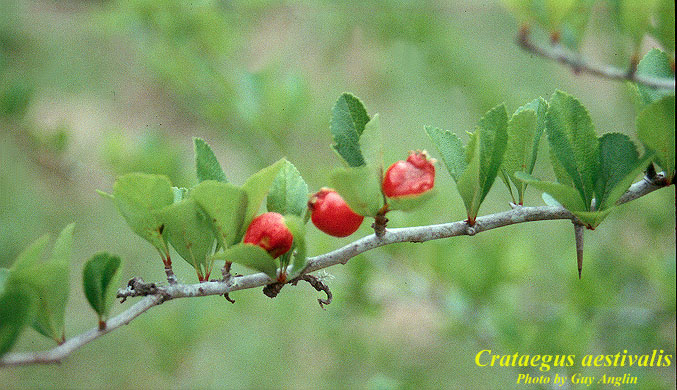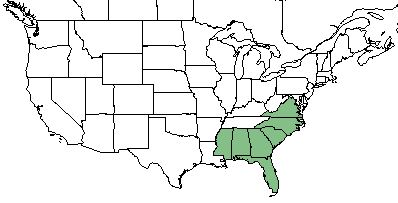Difference between revisions of "Crataegus aestivalis"
(→Description) |
|||
| Line 37: | Line 37: | ||
===Phenology=== <!--Timing off flowering, fruiting, seed dispersal, and environmental triggers. Cite PanFlora website if appropriate: http://www.gilnelson.com/PanFlora/ --> | ===Phenology=== <!--Timing off flowering, fruiting, seed dispersal, and environmental triggers. Cite PanFlora website if appropriate: http://www.gilnelson.com/PanFlora/ --> | ||
| − | ''C. aestivalis'' has been observed to flower in February, March, and May. <ref name= "PanFlora"> Nelson, G. PanFlora: Plant data for the eastern United States with emphasis on the Southeastern Coastal Plains, Florida, and the Florida Panhandle. www.gilnelson.com/PanFlora/ Accessed: 18 MAY 2018 </ref> | + | ''C. aestivalis'' has been observed to flower in February, March, and May. <ref name= "PanFlora"> Nelson, G. PanFlora: Plant data for the eastern United States with emphasis on the Southeastern Coastal Plains, Florida, and the Florida Panhandle. www.gilnelson.com/PanFlora/ Accessed: 18 MAY 2018 </ref> As well, fruiting commonly occurs in May.<ref name= "fact"/> |
<!--===Seed dispersal===--> | <!--===Seed dispersal===--> | ||
<!--===Seed bank and germination===--> | <!--===Seed bank and germination===--> | ||
Revision as of 11:10, 22 April 2019
Common name: May Hawthorn[1]; Mayhaw; Eastern Mayhaw[2]
| Crataegus aestivalis | |
|---|---|

| |
| Photo by the Atlas of Florida Plants Database | |
| Scientific classification | |
| Kingdom: | Plantae |
| Division: | Magnoliophyta - Flowering plants |
| Class: | Magnoliopsida - Dicots |
| Order: | Rosales |
| Family: | Rosaceae |
| Genus: | Crataegus aestivalis |
| Species: | C. aestivalis |
| Binomial name | |
| Crataegus aestivalis Walter | |

| |
| Natural range of Crataegus aestivalis from USDA NRCS Plants Database. | |
Contents
Taxonomic Notes
Synonyms: none
Varieties: none
Description
C. aestivalis is a perennial tree/shrub of the Rosaceae family native to North America.[1] Generally, it is a small tree that is round-topped and reaches heights of 30 feet. It has dark green leaves that are simple and alternately arranged. The flowers are white and grow either singularly or in a cluster of 2 or 3. Fruit is a red and fleshy pome, and twigs are gray to brown with spines.[3]
Distribution
C. aestivalis is common in the southeastern corner of the United States, from Mississippi to Virginia.[1]
Ecology
Habitat
C. aestivalis is most often found in swamp forests, generally where flooded for much of the year, often flowering and fruiting while standing in water, and occasionally growing as groves or stands in ‘mayhaw flats’.[2] Also often found in deciduous woods.[4] It is listed as an obligate wetland species, which occurs almost always in wetlands.[1]
Associated species: Taxodium distichum, Nyssa aquatica, Nyssa biflora, and Planera aquatica.[2]
Phenology
C. aestivalis has been observed to flower in February, March, and May. [5] As well, fruiting commonly occurs in May.[3]
Fire ecology
C. aestivalis is not fire resistant, and has a low fire tolerance.[1]
Use by animals
C. aestivalis is highly palatable to browsing animals, not highly palatable to grazing animals, and not palatable to humans.[1] However, the fruit can be used for pies, preserves, jelly, and also dried for later use.[2][3] The plant provides nesting as well as cover for small birds, which also eat the fruit. White tailed deer are also known to browse on the young stems and leaves. The wood of this plant can be used to make tool handles and mallets, and the plant can be used medicinally as a tea for high blood pressure treatment in herbal folk medicine.[3]
Conservation and Management
Cultivation and restoration
This species can be used for erosion control efforts for stream-bank and shelter belts stabilization.[3]
Photo Gallery
References and notes
- ↑ 1.0 1.1 1.2 1.3 1.4 1.5 USDA Plant Database https://plants.usda.gov/core/profile?symbol=CRAE
- ↑ 2.0 2.1 2.2 2.3 Weakley, A. S. (2015). Flora of the Southern and Mid-Atlantic States. Chapel Hill, NC, University of North Carolina Herbarium.
- ↑ 3.0 3.1 3.2 3.3 3.4 Woody, Michael L. 2012. Plant fact sheet for May Hawthorn (Crataegus aestivalis). USDA-Natural Resources Conservation Service, East Texas Plant Material Center. Nacogdoches, Texas, 75964.
- ↑ URL: http://herbarium.bio.fsu.edu. Last accessed: June 2018. Collectors: Robert K. Godfrey, Angus Gholson, H. Kurz, Sidney McDaniel, R.A. Norris, Wilson Baker, Cecil R. Slaughter, Palmer Kinsler, Edith Ellen Lee-Smith. States and counties: Gadsden County Florida, Jackson County Florida, Leon County Florida, Flagler County Florida, Lafayette County Florida, Wakulla County Florida, Atkinson County Georgia, Early County Georgia, Thomas County Georgia, Baker County Florida, Bradford County Florida.
- ↑ Nelson, G. PanFlora: Plant data for the eastern United States with emphasis on the Southeastern Coastal Plains, Florida, and the Florida Panhandle. www.gilnelson.com/PanFlora/ Accessed: 18 MAY 2018